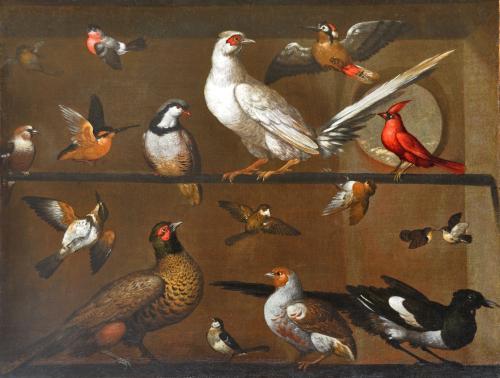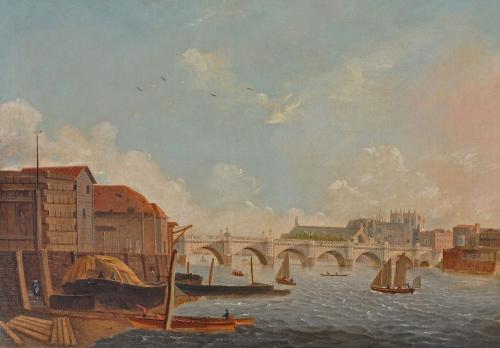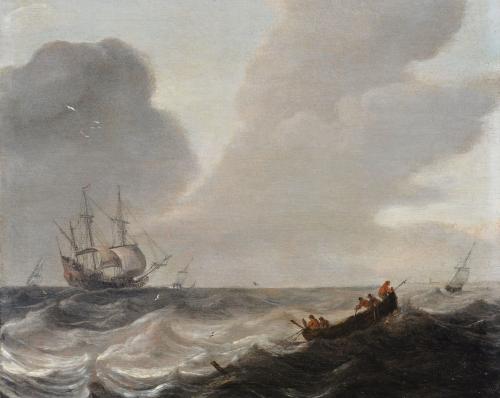





This object is eligible for a Certificate of BADA Provenance
The BADA Standard
- Since 1918, BADA has been the leading association for the antiques and fine art trade
- Members are elected for their knowledge, integrity and quality of stock
- Our clients are protected by BADA’s code of conduct
- Our dealers’ membership is reviewed and renewed annually
- Bada.org is a non-profit site: clients deal directly with members and they pay no hidden fees
ENGLISH SCHOOL 1740s
A panoramic view from the avenue of a country house in a formal park setting with an oval pool and figures and cattle in the foreground
Oil on canvas
139.7 x 180.3 cms
55 x 70 inches
Overall framed size 155.5 x 196.5 cms
611/4 x 773/8 ins
Ex Collection: The Messel Family at Nyman’s House, West Sussex until 1947 when that was burnt down and then at Holmstead Manor in the same locality.
Purchased from Oliver Messel early 1960s by Frederick and Phyllis Baden-Watkins for Flaxley Abbey.
Literature: The Artist and the Country House by John Harris; illustrated p.212.
The house, which was probably built in the 1670s or 80s, is distinctive in having four towers set at the angles of the central square block, a design which appears in some plans which were engraved by Sebastiano Serlio. The garden shows signs of being in the transitional period when the English style, implemented by such as Capability Brown and William Kent, came to the fore with the house being set in an Arcadian idyll with a naturalistic ideal landscape. This progression supplanted the more formal garden style with avenues, water features and canals so favoured as a consequence of the Dutch designers who had held sway after the Glorious Revolution. A positive identification of the house has proved elusive although it has been suggested that it bears some resemblance to Thirlestane Castle which was the seat of the Duke of Lauderdale and situated in Scottish Borders country. This is difficult to determine though as the house was extensively enlarged in the 1840s and there is no record of its appearance or even of the garden.
John Harris, writing in The Artist and the Country House from the 15th Century to the Present Day, says that: “As an art form, the subject of the Artist and the Country House, painting portraits of country houses, their gardens, or park or estate painting as it may be called, did not originate in England. But by about 1720 it had established itself there so strongly that it had become a phenomenon as nationally English as perpendicular Gothic or Tudor Renaissance. It was late in coming, but when it did, the amount of painting exceeded anything else on the continent”.
There are very few drawings by Tudor surveyors depicting country houses that have survived although there are some examples of artists from Europe being attracted to England to represent the nascent English Renaissance. Anton van den Wyngaerde in 1558/9 and Joris Hoefnagel in 1568 (who gave us the representation of Nonsuch Palace) are two examples. The earliest topographical representations of country houses in England, rather than a more architectural representation, were produced by Flemish painters, in about 1620.
There had been secular architectural studies in Italy but it did not really blossom until the 18th century in Venice. In France, there was the 1416 Les Très Riches Heures du Duc de Berry by Pol de Limbourg which displayed astonishingly realistic views of castles with sporting activities and farming in the landscapes surrounding these buildings and seen from an artificially elevated viewpoint. This tradition persisted also in Flanders and the Netherlands from this time and in France Jacques Androet du Cerceau the Elder completed volumes with bird’s eye views of chateaux and estates in the late 1570s although these did not seem to spawn a movement of painters in oils unlike as in the Low Countries.
In the 1700s, estate painting thrived in the Netherlands although it was based more around engraving and was often an amalgam of the disciplines of architectural draughtsman, surveyor and map maker. The United Provinces had a burgeoning economic prosperity at that time with a wealthy landed bourgeoisie and aristocracy who were keen to record their estates. English emigrés, fleeing the Civil Wars, had several artists and draughtsmen in their number who were fascinated by this form of topographical recording. The Restoration of 1660 saw the return of these inspired artists as well as some significant artists from the Low Countries seeking opportunities and patronage in the Stuart court such as Jacob Knyff, Hendrik Dankerts, Johannes Vorsterman, Thomas Wyck and, in 1673, Jan Siberechts who became the most influential portrayer of the English country house.
Unique to Britain was a fascination with local history, church and monastic architecture, antiquities and the families who owned and treasured them. Many landowners nurtured local artists and historians and with the founding of the Society of Antiquaries in 1707, which was a descendant of the College of Antiquaries founded in about 1586, a formalised institution came in to being to record the dilapidation of important buildings, the background of historical sites and to debate art, architecture, genealogy and heraldry.
This keen interest in how and why English castles, palaces and country houses had come into being and developed over the years with changing architectural styles, was fertile ground for the architectural painter and draughtsman. By about 1700, Leonard Knyff, started to make drawings of estates and then produce oil paintings of them. Britannia Illustrata a publication of 1707, was made up of engravings by John Kip of Knyff’s works. This was a significant catalyst for the patronage of topographical painters and combined with the encouragement of the Society of Antiquaries, this genre of painting took hold which meant that whereas previously it had been fashionable for the wealthy to have their families recorded in portraiture, now the house and estate was recorded on canvas, sometimes after significant alterations to the house or gardens or at other times, just before these works were undertaken so as to have a historical record.
By the early first half of the 18th century, English artists had seen the opportunities available and painters such as Thomas Smith of Derby (fl.1743-1767) George Lambert (1710-1765), John Wootton (c.1686-1765), Thomas Badeslade (fl.c.1715-1750) Matthias Read (1669-1747) and John Setterington (op.1728-1750) were working on commissions as were the second wave of Low Countries born painters like Robert Griffier (1688-c.1760), Pieter Tillemans (1684-1734) and Pieter Andreas Rysbrack (c.1684-1748)
Bibliography:
The Artist and the Country House – John Harris
Prospects of Town and Park - National Art Collections Fund catalogue 1988
The BADA Standard
- Since 1918, BADA has been the leading association for the antiques and fine art trade
- Members are elected for their knowledge, integrity and quality of stock
- Our clients are protected by BADA’s code of conduct
- Our dealers’ membership is reviewed and renewed annually
- Bada.org is a non-profit site: clients deal directly with members and they pay no hidden fees









